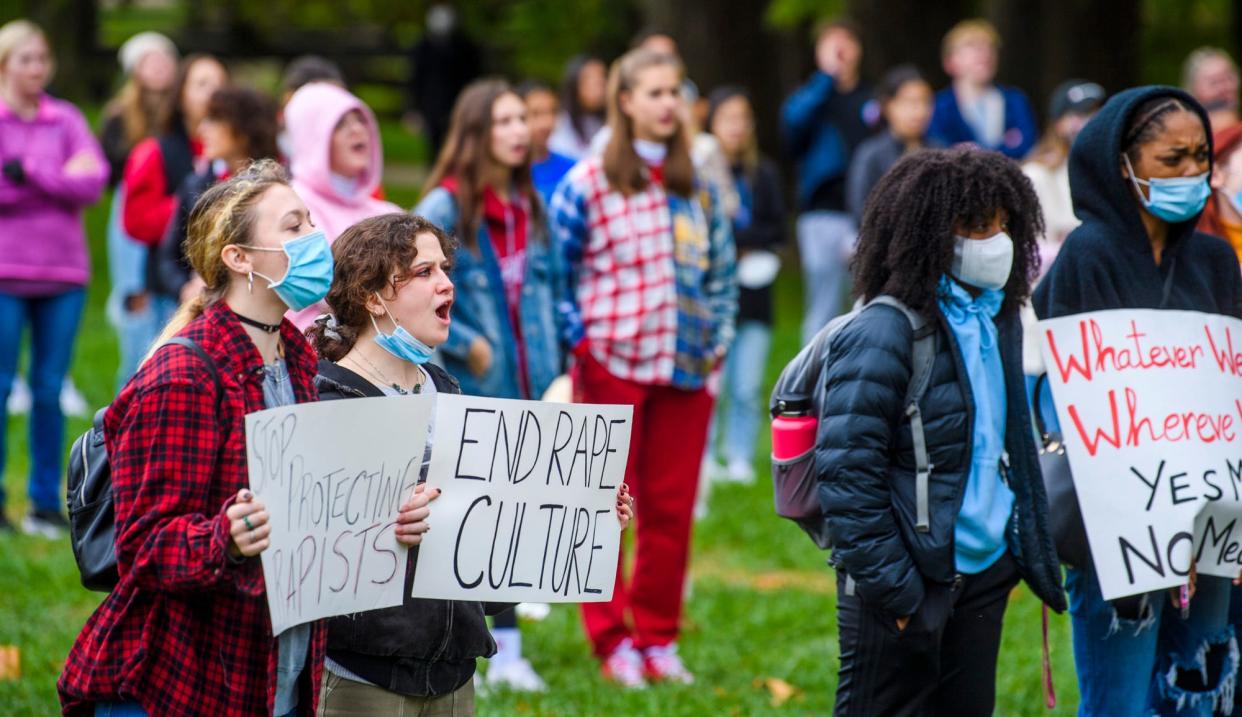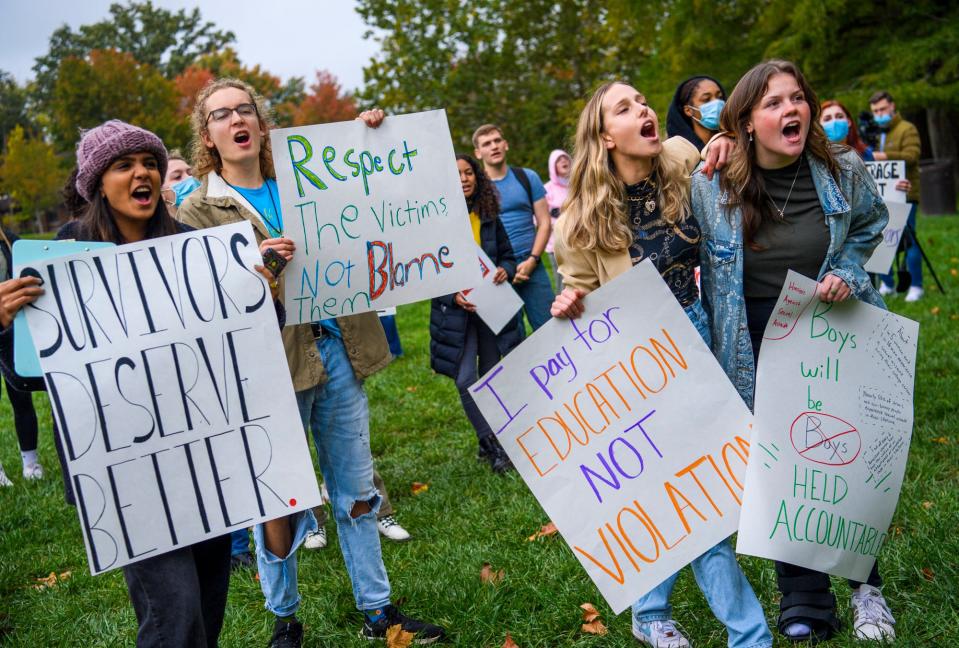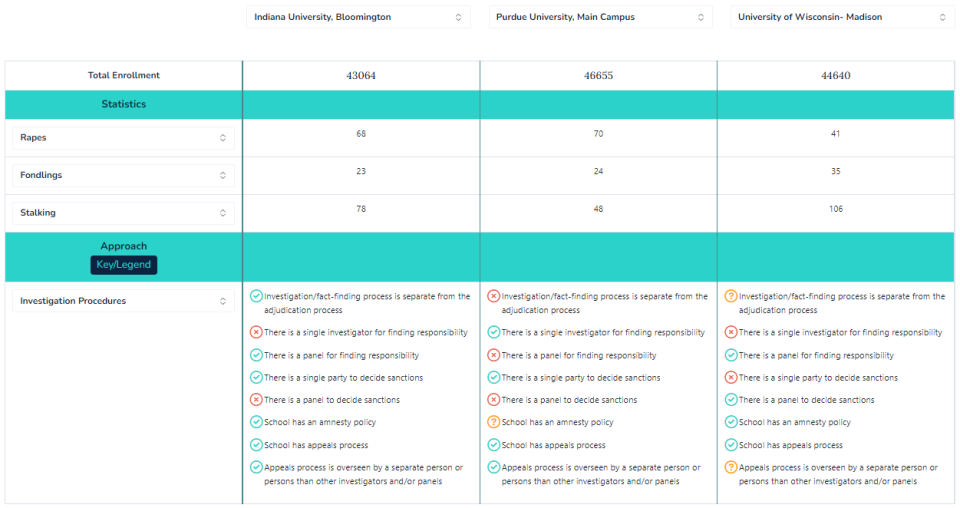New tool compares safety, sex assault stats at colleges. How do Indiana universities rank?

While trying to decide which college to begin your post-secondary education in the fall, a lot of questions spring to mind: What sort of programs are offered, how are the living and dining accommodations — and just how safe is the campus?
Under federal law, most universities are required to publish safety data, which includes what sort of crime is occurring on or around campus, as well as specific policies and procedures outlining preventative and disciplinary actions for offenses. However, that information is often spread out across multiple databases and systems, prompting one advocacy group to create a new one-stop shop centralizing nearly a thousand college campuses' sexual assault statistics, investigatory procedures and survivor resources.
Change in reporting:IUPD hasn't disclosed locations of most sexual assaults in fall 2021. Students noticed.
What is CAMT? Why was it created?
End Rape on Campus is a nonprofit based in Washington, D.C., seeking to end sexual violence on college campuses through direct support resources, prevention programming and policy reform at local and federal levels. Part of this organization's recent efforts is the Campus Accountability Map & Tool (CAMT), which its creators describe as a revolutionary step forward in ensuring an institution is accountable for on-campus sexual assaults.
The website has compiled reported sexual assault statistics from 2018 to 2020 for over 750 universities across the United States — including seven college campuses in Indiana. Advocates hope this tool can provide new critical insight during the college selection process by allowing potential students to compare how well educational institutions address and work to prevent sexual assaults on campus.
What is the Clery Act?
Under the Jeanne Clery Disclosure of Campus Security Policy and Campus Crime Statistics Act, higher education institutions participating in federal financial aid programs must disclose information about crime on and surrounding campus in a publicly accessible format. The law also outlines specific policies and procedures related to improving campus safety.
This disclosure is required to take many different forms — a published annual campus security report, a public log of all crimes reported to the university's police or security department, a years-long record of crime statistics, and an emergency alert system for active threats to safety on or near campus.
An institution's compliance is monitored by the United States Department of Education, which can launch investigations into complaints of Clery Act violations.
Where does CAMT get its data?
Though the Clery Act mandates this crime-related data is available, it isn't always easy to find. Because there are various avenues of required reporting, this disclosure can be scattered across a university's system. While IU Bloomington provides a webpage that centralizes its resources, policies and reporting process, this isn't the case on every campuses.
CAMT relied on a network of volunteers to scour university webpages, including IU Bloomington's, and federal databases, such as the Department of Education's Clery Reports, in order to compile the crime statistics, reporting policies and survivor resources in one aggregated, standardized place.
How is the information organized and displayed?
Here's how it works: Students can look up a university by its specific address or state. Once selected, the website shares basic information about the college campus such as its enrollment size and how many cases of sexual assault-related crimes were reported in total between 2018 to 2020. In addition to these statistics, viewers can read what sort of services and policies are offered at the campus in a question and answer or checklist format.
CAMT also provides a comparison option where a person can stack up to three schools side by side and see how their statistics, policies and survivor resources differ.

How does Indiana University Bloomington rank in terms of campus safety?
Between 2018 to 2020, IU had 63 rape, 23 fondling, 38 domestic or dating violence and 78 stalking reports on its Bloomington campus, according to CAMT.
The tool notes IU Bloomington has a comprehensive understanding of affirmative consent, a gender neutral definition of sexual assault, and a sexual assault survivor support or advocacy center, which are considered positive attributes. In lesser form, the website notes the campus also has pending Title IX investigations.
While CAMT lists the campus as having above the national average for each listed crime category, IU Bloomington does score better than several of its peer universities with comparable enrollment sizes.
How does IU compare to other Big Ten schools?

When looking at comparisons, it's important to match enrollment size and location as much as possible.
At Purdue University's main campus, which has around the same enrollment and is similarly located in a relatively small, non-metropolitan area, statistics show 70 rape, 24 fondling and 42 domestic or dating violence cases between 2018 to 2020. However, Purdue does have considerably smaller instances of stalking than IU, reporting 30 fewer cases.
Big Ten college campuses in more metropolitan areas reported similar data. University of Wisconsin's Madison campus has had 41 rape, 35 fondling, 75 dating or domestic violence and 106 stalking reports in the same three-year period.
University of Michigan's Ann Arbor has extraordinary circumstances, placing its campus as a glaring outlier. During that same time, U-M's Ann Arbor campus has had 1,289 rape, 1,019 fondling, 79 domestic or dating violence and 92 stalking reports. Most of U-M's sexual assault reports seem to stem from a recently uncovered sexual abuse investigation involving the former U-M athletic doctor Robert Anderson. While Anderson stopped working at the university in 2003 and died in 2008, several former students have since accused the doctor of sexual abuse during Anderson's 35-year employment at U-M. According to local reports, 1,212 rapes involving Anderson were reported to University of Michigan officials during the 2020 fiscal year.
How many Indiana colleges are rated?
While the tool continues to add more universities to its database, people can see statistics for Indiana campuses such as Ball State University, Goshen College, IU's Bloomington and Northwest campuses, Purdue's main and global campuses and University of Southern Indiana.
Through this website, Hoosiers can compare local campuses and see how they stack up. For example, of these colleges, a little more than half are currently under investigation for Title IX complaints by the U.S. Department of Education; IU's Northwest campus, Purdue's Global-Lincoln campus and University of Southern Indiana do not have open investigations.
People can access CAMT at https://endrapeoncampus.org/map-and-tool.
Reach reporter Rachel Smith at rksmith@heraldt.com.
This article originally appeared on The Herald-Times: Website makes finding data on college campus sexual assaults simple

